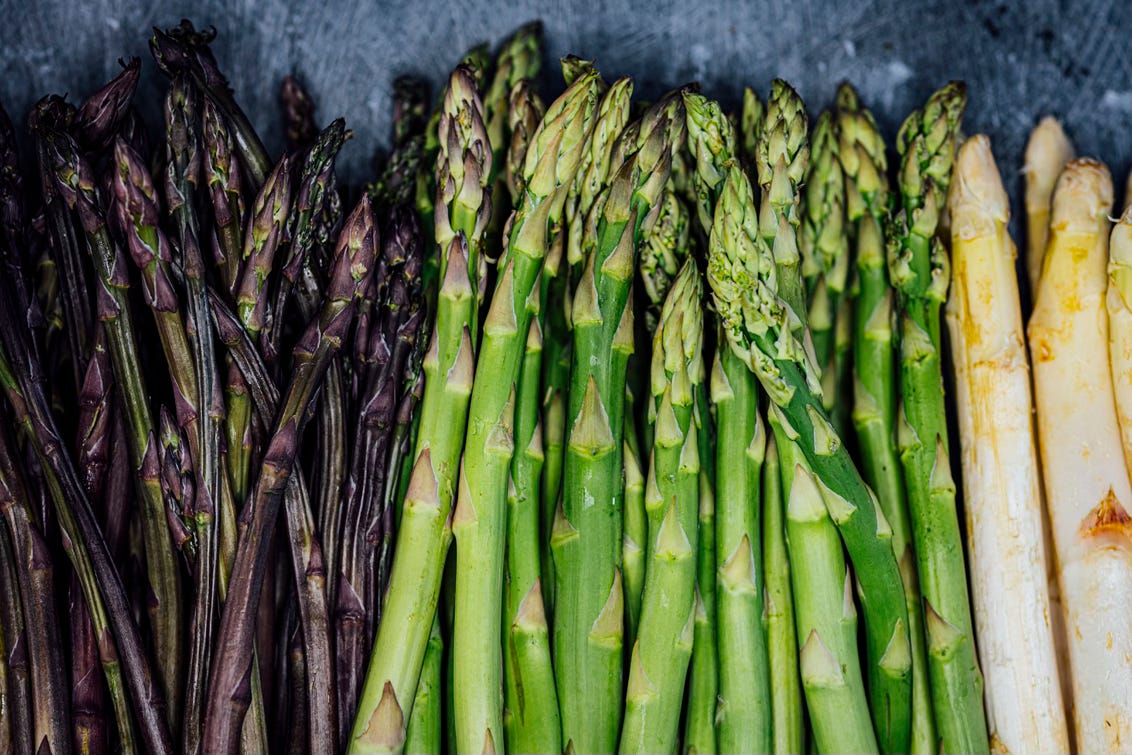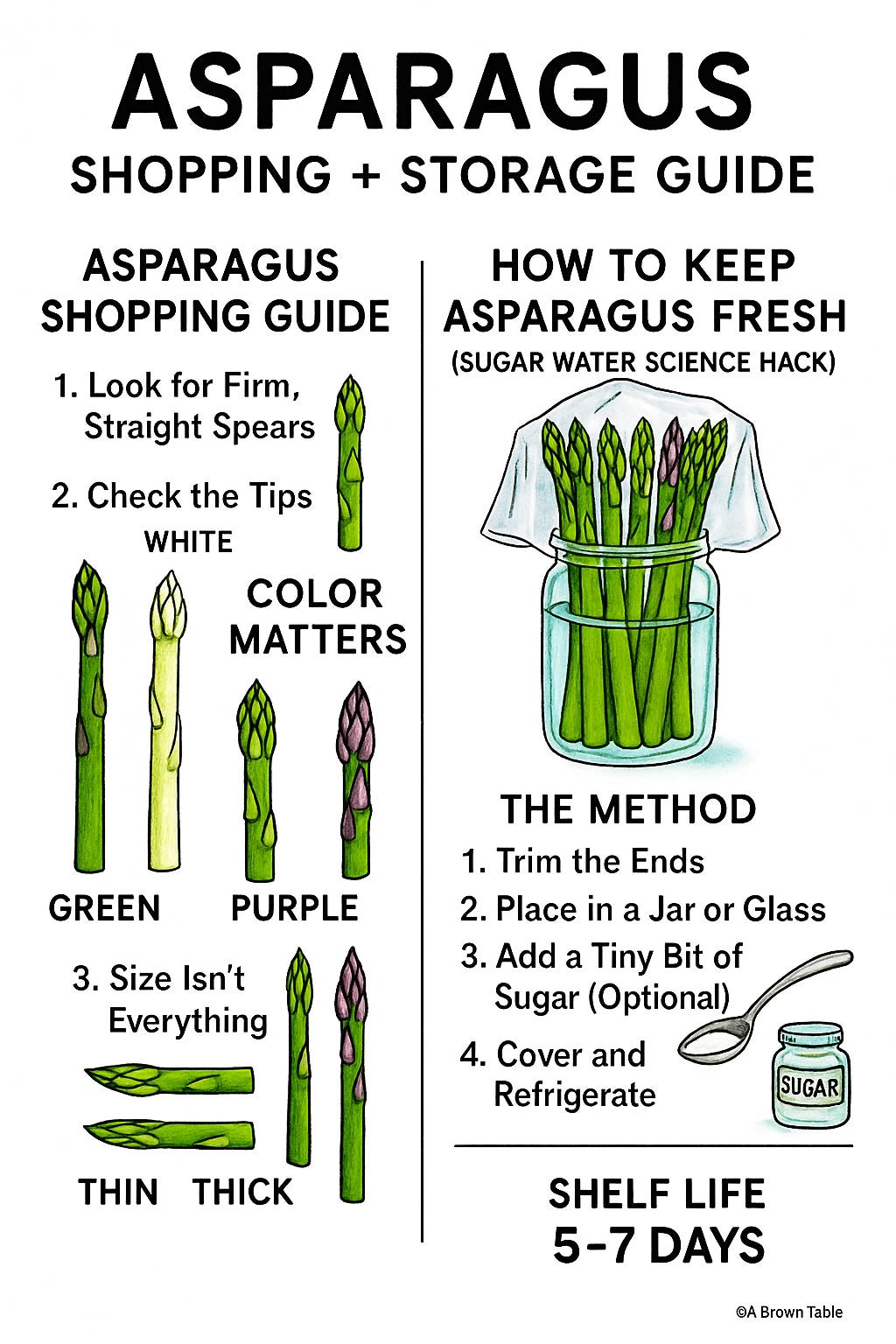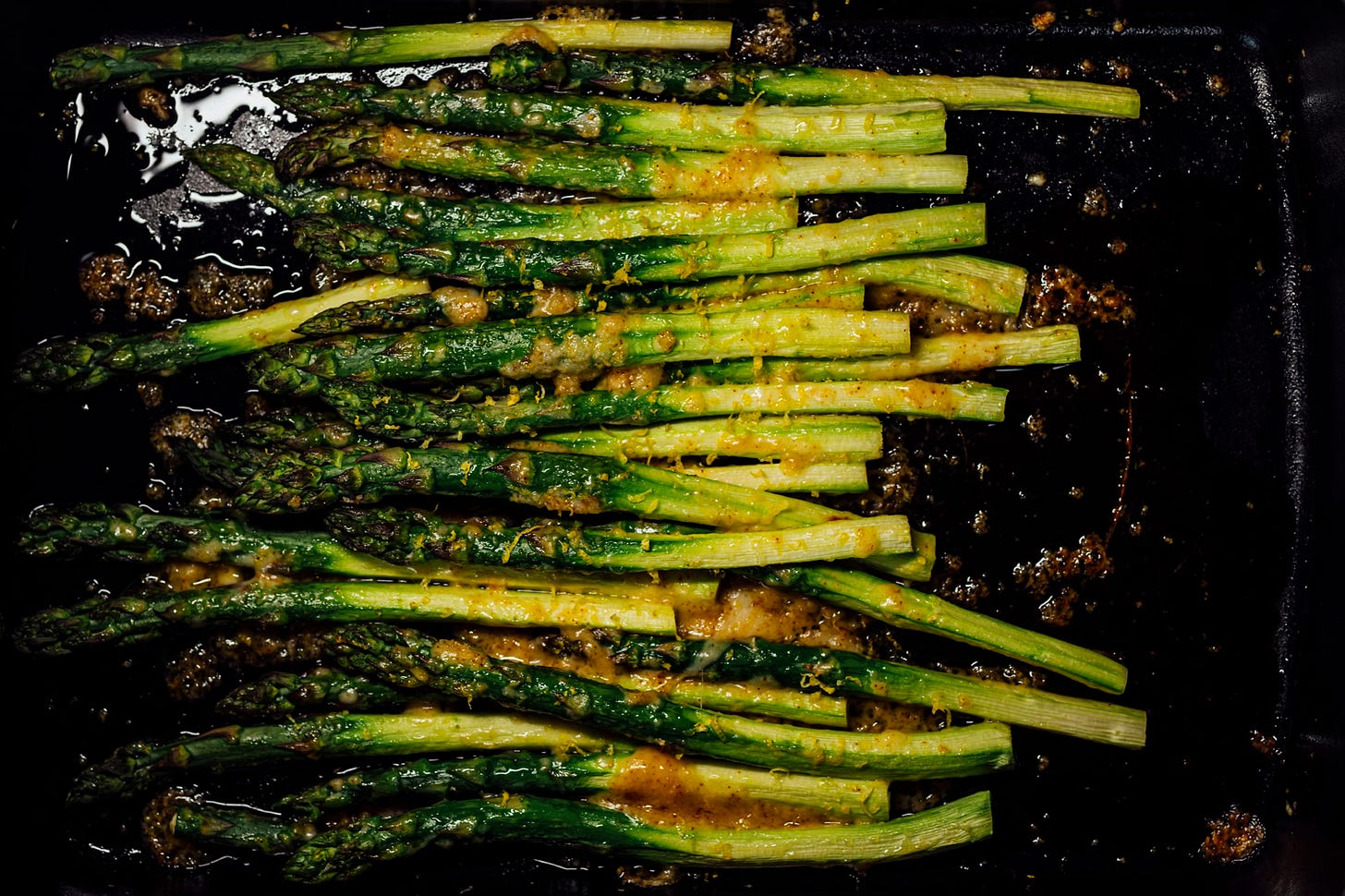The Day Asparagus Made Me Google ‘Sudden Onset Deadly Body Odor'
What Asparagus Season Tastes Like—Garlic, Lemon, Parmesan, and a Hint of Heat
Welcome to The Flavor Files—Summer Edition. ☀️
Here’s where my love of cooking, food science, and peak-season produce all come together. From juicy tomatoes to smoky grilled peaches, summer ingredients deserve a little chemistry and a lot of flavor.
Want more recipes? You’ll find them all at Nik Sharma Cooks.
Still need a copy of Veg-Table? Grab it here—it’s full of ideas to make vegetables the star of your summer table. 🌿🍆
This newsletter includes the occasional affiliate link—they help keep the spice (and the science) flowing.
Now let’s dive into the good stuff—because summer won’t wait. 🔥
The first time I ate asparagus was awkward and mildly terrifying. It’s not a common vegetable in India, so I’d never seen it until it showed up as a roasted side dish at a restaurant in Cincinnati. I loved its crisp-tender texture and the nutty, slightly grassy flavor. So I went all in. Possibly too in.
About an hour later, I took a trip to the restroom, and that’s when the existential dread kicked in. A strange, sharp odor hit me—something sulfurous and… frankly alarming. I was convinced my kidneys were failing or that I had minutes left on this planet. Too embarrassed to ask anyone, I waited until I was alone, then launched into a frantic Medline search for “sudden onset deadly body odor.”
That rabbit hole led me straight to asparagusic acid, a sulfur-containing compound unique to asparagus. When digested, it breaks down into volatile molecules that get excreted in urine, giving rise to that notorious smell. But here’s the twist: not everyone notices it. Some people don’t produce the smelly compounds at all, while others do but lack the specific receptors to detect them.
In other words, if you’ve never noticed a weird asparagus smell in the bathroom… congratulations, you’re either a non-producer or your nose is genetically blessed.
Why We Still Don’t Fully Understand the Asparagus Pee Phenomenon
Asparagus is famously rich in sulfur-containing compounds, especially asparagusic acid, which breaks down in the human body into volatile, often pungent-smelling molecules. But here’s the twist: despite decades of study, we still don’t fully know which exact chemicals are responsible for the odor, or why only some people seem to detect it.
That surprised me.
In grad school, one of the core lessons we learned when testing hypotheses was this: it’s not enough to observe an interesting effect — you have to prove it, challenge it, recreate it. So in this case, let’s say you detect sulfurous compounds like methanethiol or dimethyl sulfide in urine post-asparagus. Interesting, yes.
But here’s the scientific standard: If you remove those molecules and add them back in, do people still smell the same odor?
And if they do, is that smell identical to what happens after eating asparagus?
The answer so far is: not exactly.
Multiple studies have identified likely candidates for the smell, including various volatile sulfur compounds; however, no one has been able to reproduce the full “asparagus bouquet” from scratch. In short, we’ve found some of the suspects, but haven’t reassembled the crime scene. These molecules may be present, but we haven’t definitively shown they’re both necessary and sufficient to account for the whole odor.
What we do know, thanks to large-scale genetic studies (like the one by 23andMe), is that most people produce the smell, but not everyone can detect it. Smelling it — or not — is primarily a function of olfactory receptor gene variants. Your body might be excreting the funk, but your nose might not be wired to notice.
But here’s where I need to raise a red flag:
Those studies were conducted almost entirely on individuals of Northern European ancestry. Which means the findings, while fascinating, are not universally applicable.
In India, where I grew up, asparagus isn’t a staple. The data on whether South Asians, people from Africa, Southeast Asia, or the Middle East, can detect odors is essentially nonexistent. The genetic variants associated with “asparagus anosmia” may be absent or behave differently in those populations. Scientists need to study larger populations and conduct more controlled studies.
So yes, asparagus pee is a funny cultural reference. Still, it’s also a case study in how scientific conclusions get shaped by who we study, what we measure, and what assumptions we make about universality.
In short, the asparagus mystery isn’t fully solved. The chemistry is still inconclusive. And the genetics? Likely more diverse than we’ve measured so far.
The Asparagus Guide
Asparagus Shopping Guide
Look for Firm, Straight Spears: Stalks should feel crisp, not bendy or limp. Avoid wrinkled or shriveled ends.
Check the Tips: The tips (aka the buds) should be tightly closed and compact, not mushy, flowering, or frayed.
Color Matters: Green asparagus should have vibrant, bright-green stalks with a slight purple tinge at the tips. White asparagus should be ivory, not gray or dried out. Purple asparagus should be evenly colored without fading or brown spots.
Size Isn’t Everything: Thin spears cook faster and are great for quick sautés or roasting. Thicker spears have a meatier bite and are better for grilling or blanching. Both are equally tender when fresh; adjust your cooking time accordingly.
How to Keep Asparagus Fresh (Sugar Water Science Hack)
Asparagus is essentially a flower stalk, and like cut flowers, it stays fresher when stored upright in water. Here’s how to extend its life:
The Method:
Trim the Ends: Cut about ½ inch [13 mm] off the bottom of the stalks.
Place in a Jar or Glass: Stand the spears upright in a glass or jar with about 1 in [2.5 cm] of cold water.
Add a Tiny Bit of Sugar (Optional): Stir in ½ teaspoon sugar per cup of water. Why? Sugar feeds the stalks and keeps them metabolically active a bit longer; it’s plant life support.
Cover and Refrigerate: Loosely cover the tops with a produce bag or plastic wrap. Change the water every couple of days.
Shelf Life: This method can keep asparagus crisp and flavorful for 5 to 7 days, sometimes longer, especially if they were super fresh at purchase.
Asparagus Recipes to Cook
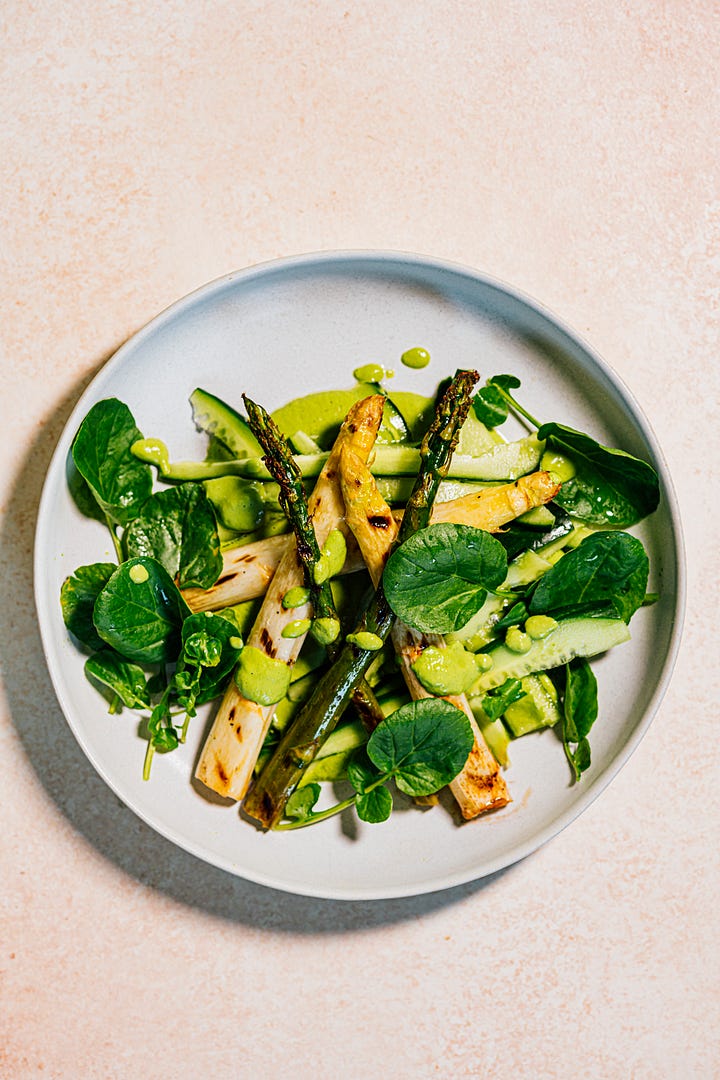
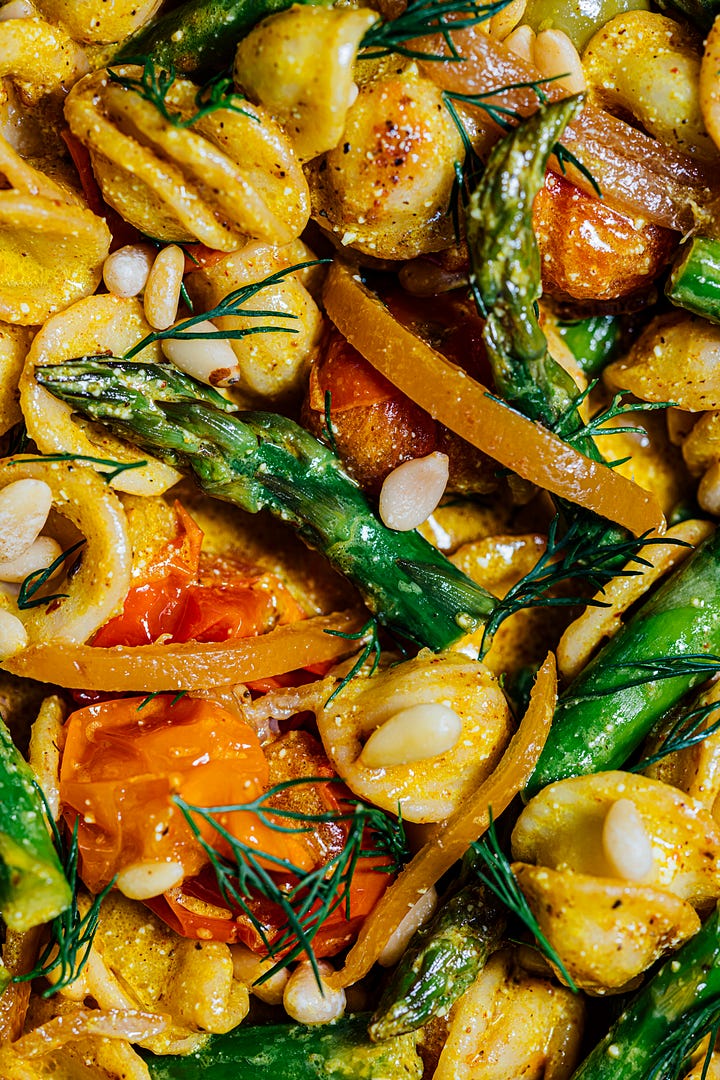
Grilled Lamb Chops with Asparagus and Green Beans
Asparagus Gribiche Pizza (Paid Subscribers)
Slice of Summer: Sizzling Pizzas, Tangy Lemonades, and Frosty Popsicles
Welcome to The Flavor Files, a newsletter that explores the intersection of science and food. You’ll receive a new recipe, links to more recipes, food and science news, and more each week.
Charred Asparagus with “Gunpowder” Nut Masala (The Flavor Equation Cookbook)
The Veg-Table cookbook has a whole chapter of recipes on Asparagus!
Lemon, Garlic, Parmesan Asparagus
A bright, bold riff on the classic lemon-asparagus combo. I layer the lemon zest, half before cooking, half after, to coax out both warmth and fresh citrusy zing. Garlic and a hint of cayenne enhance the savory notes, accentuating the umami-rich saltiness of Parmesan. It’s fast, flexible, and just elegant enough to land on any weeknight or dinner party table. Peel those thick woody stems, it will ensure a more tender asparagus.
Keep reading with a 7-day free trial
Subscribe to The Flavor Files to keep reading this post and get 7 days of free access to the full post archives.




